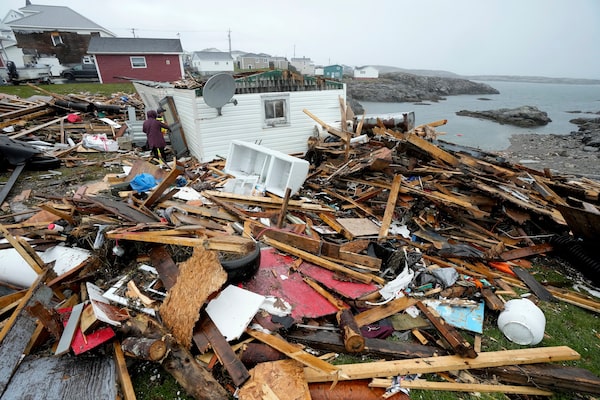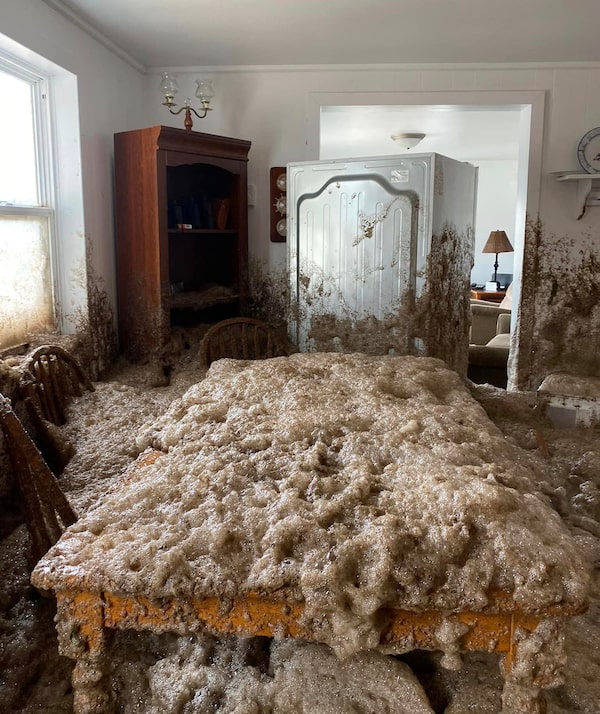
A resident and search and rescue worker examine the destroyed remains of a home in Port aux Basques, N.L., on Sept. 26.Frank Gunn/The Canadian Press
With insurance for coastal flooding damage largely unavailable, much of the recovery costs from post-tropical storm Fiona that swept through Canada’s eastern provinces on Saturday will likely be borne by homeowners and government disaster financial assistance programs.
The total cost of damages has yet to be determined but estimated losses could range between $300-million to $700-million of insurance claims, said Marcos Alvarez, the head of insurance of DBRS Morningstar. Hurricane Juan in 2003, the most expensive hurricane or wind event in Atlantic Canada in terms of insured losses, cost $192-million.
The wide range in estimates is a moving target that will depend on how many home and business policyholders purchased additional protection for weather-related damages, Mr. Alvarez said in an interview with The Globe and Mail.
Ottawa to deliver financial aid for uninsured people affected by post-tropical storm Fiona
Atlantic Canada takes stock of devastation caused by Hurricane Fiona’s wrath
“A hurricane is not a frequent event for the Canadian East Coast so it really depends on what each individual insurance policy covers; so certain homeowners will not have purchased any type of flood coverage for their house because it is not typically something they are automatically provided upfront in a policy. And that is a problem,” Mr. Alvarez said.
Insured damages from Fiona will also depend on the number of business interruption claims – as well as the duration of company closings – submitted by commercial policyholders.
“The impact of being closed for a long length of time for some of these companies may be greater than any physical damage they incurred – and can end up costing millions in claims,” Mr. Alvarez said.
Post-tropical storm Fiona hit Nova Scotia, New Brunswick, Prince Edward Island, Newfoundland and Quebec’s Magdalen Islands on Saturday morning, slamming homes and businesses with hurricane-strength winds, dangerous ocean storm surges and heavy rain. Environment Canada said it expects the storm’s central pressure will be the lowest barometric pressure recorded in Canadian history.
Canadian military personnel arrived in Nova Scotia on Monday to do reconnaissance work ahead of operations to restore transportation and remove debris, while crews have been working all weekend to restore power across the Atlantic region.
But the lack of storm-surge coverage offered by insurers is leaving a number of Canadians out-of-pocket for coastal flooding to their homes.
Residential home insurance policies typically don’t offer automatic coverage for flood damage – and even the vast number of add-on flood policies do not include damages from storm surges, said Amanda Dean, vice-president, Atlantic, for the Insurance Bureau of Canada, an industry association.
“Insurance works by pulling together the premiums of many with similar risk profiles to pay a few customers with similar risk profiles,” she added. “With coastal dwellings, only a small portion of customers share the same risk and therefore the pool is too small and the risk too high to make the coverage affordable.”
Craig Stewart, the Insurance Bureau’s vice-president of federal affairs, said he knew of only one insurance company – The Co-operators Group Ltd. – that offers storm-surge insurance.
“Our understanding is that it’s very limited in scope so far,” he said. “It’s very limited as far as where it’s available. And it’s expensive.”
He added that many insurers are reluctant to offer that product because there’s little coastal flood risk modelling available from data providers, making it difficult to identify at-risk areas and price the insurance.
Lisa Guglietti, an executive vice-president at Co-operators who oversees products and pricing, said her company began offering storm-surge coverage in Atlantic Canada in 2018 as part of comprehensive water coverage. The pricing reflects a wide array of factors individual to the property, including elevation, zoning and defences in the area. Insuring high-risk costal properties can be very costly.
“If you’re prone to hurricanes or storm surge, or coastal flooding, the cost will reflect that,” she said.
“This is a very difficult conversation to have with the client, to tell them that they’re exposed to these types of risks if it’s something they’ve never heard before.”

This image provided by Kathy Ingram MacKinnon on Sept. 25 shows damage caused by Hurricane Fiona in Neils Harbour, N.S.KATHY INGRAM MACKINNON/Supplied
Ms. Dean said the insurance industry has been working with the federal government to create a national insurance program for all overland flooding that offers protection to all Canadians.
“However, this plan is very much in its infancy and no one leading up to Fiona would have had storm-surge protection on their home insurance policy,” Ms. Dean said.
Mr. Stewart said taxpayers typically pay for disasters like Fiona through disaster financial assistance programs.
Three stories of resilience as Atlantic Canada residents begin post-Fiona recovery
The Disaster Financial Assistance Arrangements (DFAA) is a cost-sharing program between the two senior levels of government. Its formula leaves provinces and territories on the hook for minor disasters, but Ottawa picks up proportionally more of the tab for severe events.
Data from Public Safety Canada show that the federal government paid out after several named storms, including Juan in 2003, Chantal in 2007, Igor in 2010 and Dorian in 2019. Of those, Igor was the most expensive: The federal government’s share of the recovery costs amounted to $85-million.
In Fiona’s wake, the governments of Nova Scotia and New Brunswick announced that they are accepting applications for disaster financial assistance. New Brunswick urged residents to report property damage from Fiona to a government hotline or website, keep receipts for any repairs or replaced belongings, and log the number of hours they work cleaning up.